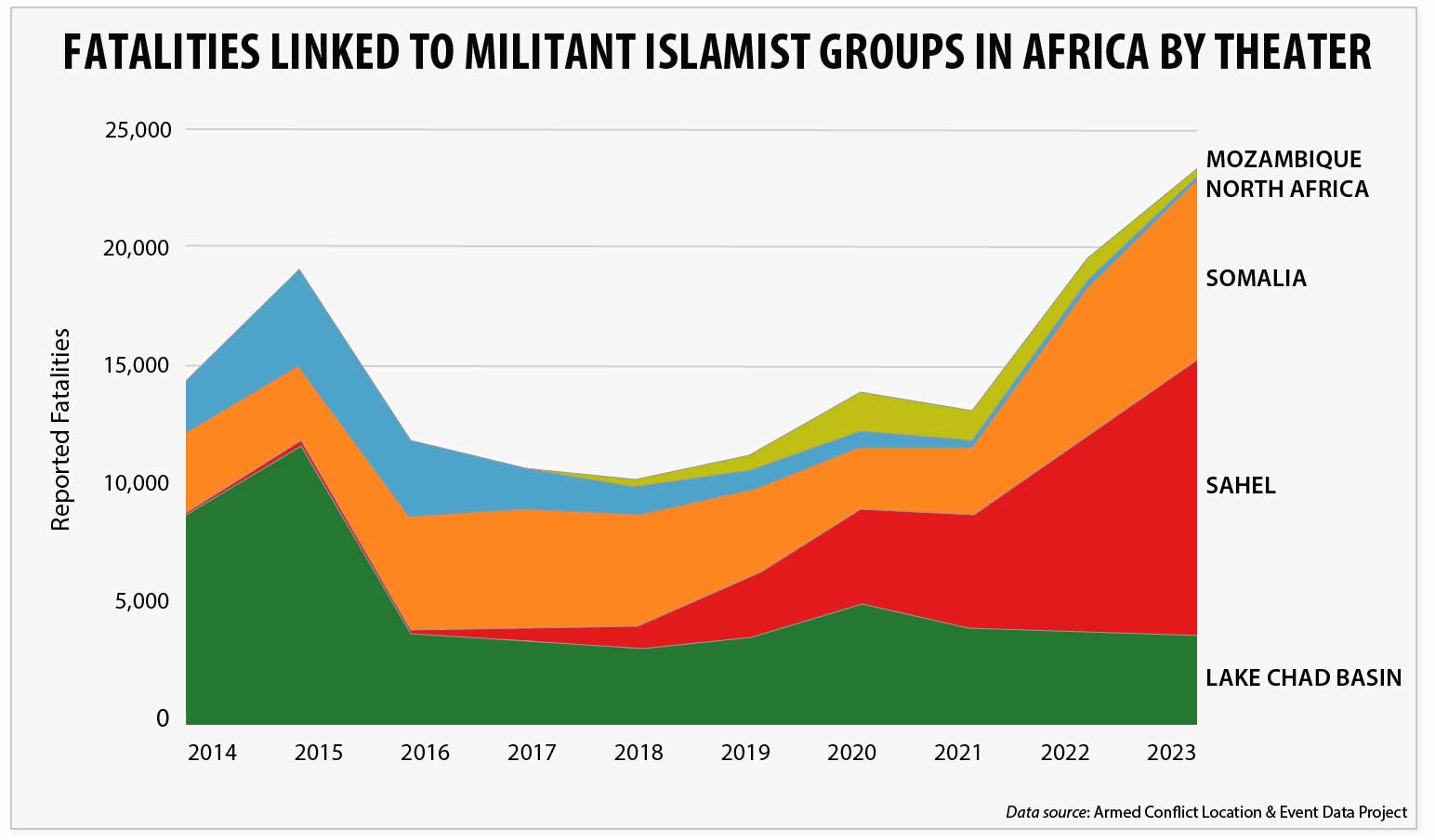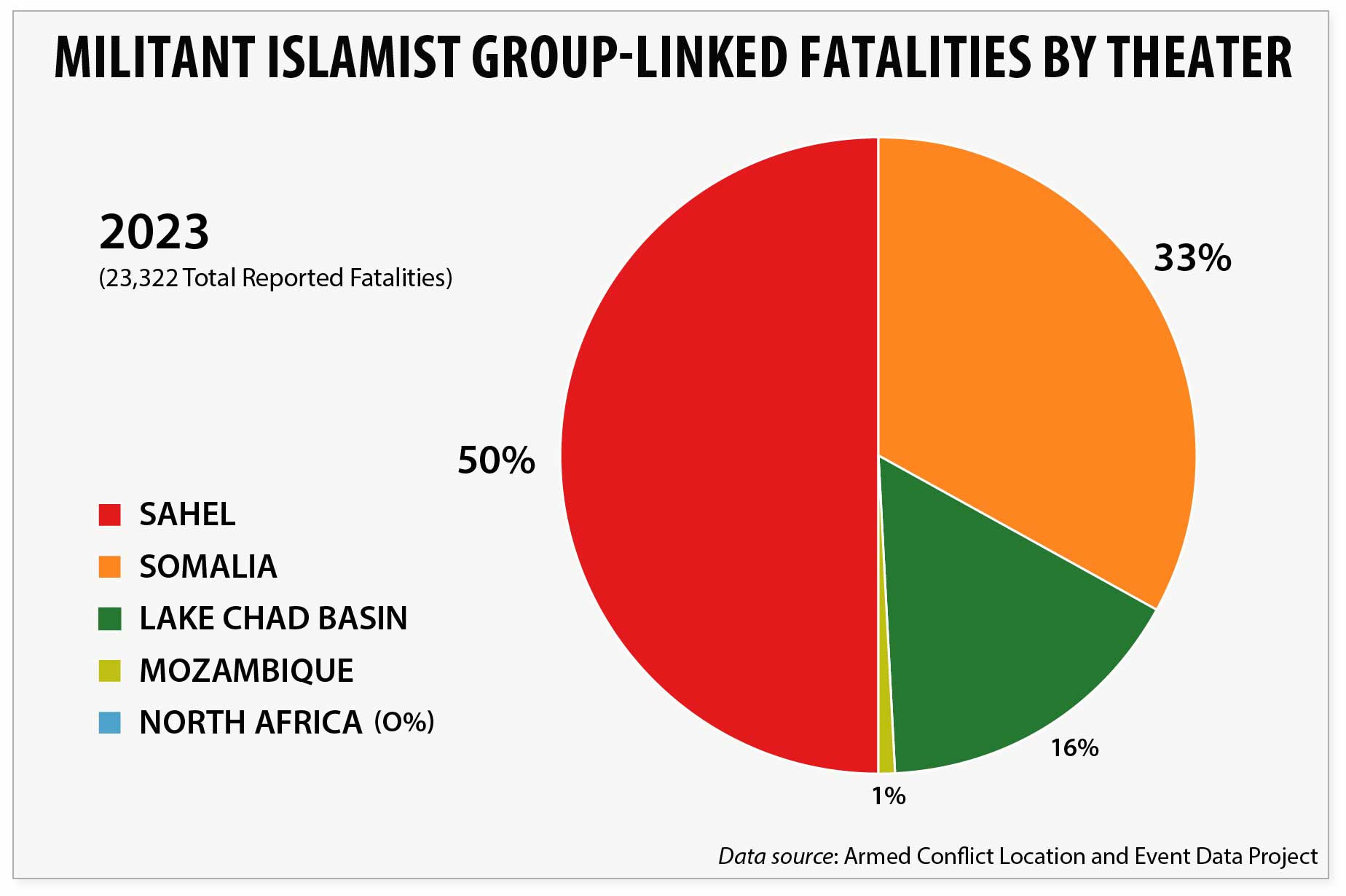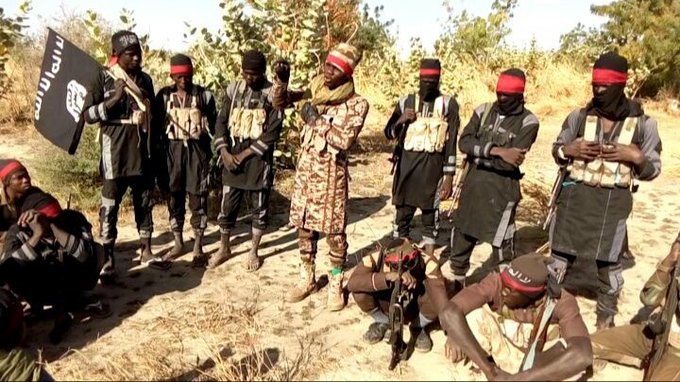Fatalities linked to militant Islamist violence jumped by 20 percent in the past year, claiming more than 23,000 lives—a new record. Over 80 percent of these deaths were in the Sahel and Somalia.
- Fatalities linked to militant Islamist violence rose by 20 percent in the past year (from 19,412 in 2022 to 23,322) — a record level of lethal violence. This represents a near doubling in deaths since 2021.
- 83 percent of the reported fatalities have been in the Sahel and Somalia. The two regions saw 43 percent and 22 percent annual increases in the number of violent extremist-linked deaths, respectively.

- The picture across the continent varied widely, however. Both North African and Mozambican theaters saw dramatic reductions—98 percent and 71 percent, respectively—in the number of fatalities linked to militant Islamist violence.
- These declines illustrate the progress that can be made against militant Islamist groups in Africa.
- Due to the drops in violent activity in these two regions, the Sahel, Somalia, and the Lake Chad Basin now account for 99 percent of the fatalities linked to militant Islamist groups in Africa.
- The declines in violent activity in North Africa and Mozambique contributed to a 5-percent drop in the number of violent extremist events across the continent over the past year—6,559.
- This is the first decline in the number of violent incidents linked to militant Islamist groups in Africa since 2016, when there were 2,513 violent events.
- This drop was accompanied by a 13-percent decline in fatalities linked to violence against civilians, reflecting decreases in all regions except the Sahel.

Sahel
- The estimated 11,643 fatalities linked to militant Islamist violence in the Sahel mark a record high for any of the five African theaters since the peak of the Boko Haram violence in 2015.
- Fatalities in the Sahel represent a near threefold increase from the levels seen in 2020, when the first military coup in the region occurred—ostensibly justified on the grounds of insecurity.
- Fatalities in the Sahel amounted to 50 percent of all militant Islamist-linked fatalities reported on the continent in 2023. By comparison, the Sahel accounted for 30 percent of the continent’s militant Islamist-linked fatalities in 2020.
- Violence against civilians accounts for 35 percent of all militant Islamist-related events in the Sahel—the highest of any region in Africa.
- Given dramatically shrinking space for media to report on the worsening security since the coups in Mali, Burkina Faso, and Niger, the number of violent events and fatalities linked to the militant Islamist groups in the region is likely underreported.
- Most of the surge in fatalities is linked to the Jama’at Nusrat al Islam wal Muslimin (JNIM) coalition, particularly the Macina Liberation Front (FLM) and Ansaroul Islam. The coalition was associated with a 67-percent spike in reported deaths—to 9,195 versus 5,499 in 2022.
- The JNIM coalition is associated with 81 percent of militant Islamist violence in the Sahel.
- Fatalities associated with the Islamic State in the Greater Sahara (ISGS), in contrast, saw a 7-percent drop in 2023 (to 2,448 fatalities).
- Burkina Faso experienced 67 percent of the militant Islamist-related fatalities in the Sahel (7,762). This is more than double the number of deaths recorded in 2022.
- This is the third year in a row Burkina Faso has experienced the most extremist violence in the region. Militant Islamist groups, primarily Ansaroul Islam and other JNIM entities, have laid siege on at least 36 Burkinabe towns and now control more than half the country’s territory.
- Mali accounts for 34 percent of reported militant Islamist violence in the region (1,014 events and 2,863 deaths).
- Niger, which suffered a coup in the middle of 2023, saw a 9-percent increase in violence from 2022 (to 231 reported events) and a 48-percent jump in related fatalities (793). Most of these fatalities occurred after the coup. The vast majority (93 percent) of fatalities linked to violence against civilians in Niger is from the ISGS (242 fatalities).
- Benin continued to experience an escalation of militant Islamist violence in its northern region. As a result of the spillover from Burkina Faso, there was a doubling of reported violent events and fatalities (to 150) in Benin in 2023. Militant Islamist violence in Togo plateaued in 2023, meanwhile, with 14 reported events and 69 fatalities.
- Best estimates are that there are more than 330,000 refugees and 2.5 million internally displaced people (IDPs) from Burkina Faso, Mali, and Niger. There are over 2 million IDPs in Burkina Faso alone.
Somalia
- Somalia saw a 22-percent increase in fatalities in 2023—reaching a record high of 7,643 deaths. Virtually all of this violence is attributed to incidents involving al Shabaab.
- This represents a tripling of fatalities since 2020.
- The majority of violent events (65 percent) and fatalities (77 percent) were linked to battles, reflecting the continued offensive led by the Somali federal government against al Shabaab.
- Kenya experienced a doubling in the number of fatalities (279) resulting from violence with al Shabaab in 2023, primarily along the Somalia border. An estimated 96 percent of fatalities in this region are in Somalia, however.
- The conflict, combined with drought and flooding, has resulted in 4.3 million people facing Crisis levels and above (IPC Phase 3+) of food insecurity in Somalia.
Lake Chad Basin
- Militant Islamist group violent events grew by a quarter over the last year (to 1,203), reversing declines in violence the region had seen since 2020.
- The 3,769 fatalities linked to these violent events marked a continued plateauing in deaths in recent years. Nevertheless, the Lake Chad Basin theater remains the third most deadly on the continent, comprising 16 percent of all militant Islamist-linked fatalities.
- Boko Haram and Islamic State in West Africa (ISWA) are linked to nearly all violent extremist events in this region, while Ansaru, located in the northwestern part of Nigeria, was mostly absent.
- Violent events linked to Boko Haram and ISWA are evenly distributed, though they vary by type. ISWA is linked to more battles and remote violence and their related fatalities, while Boko Haram is responsible for 59 percent of the attacks on civilians. This corroborates past reports that Boko Haram is the more predatory of the two groups.
- In the effort to control territory, resources, and fighters, Boko Haram and ISWA are fighting each other as well as the militaries in the Lake Chad region. This is in addition to the generalized violence and criminality experienced primarily in northwest Nigeria, where 3,600 people were kidnapped and many killed in 2023.
Northern Mozambique
- Militant Islamist violence in northern Mozambique saw a 71-percent drop over the past year. There were 127 violent events and 260 fatalities reported in 2023.
- This change can be attributed to last year’s offensive by the Southern African Development Community (SADC) and Rwandan forces who were deployed in July 2021 to help the Mozambican military dislodge the extremists from the cities of Palma and Mocimboa da Praia.
- The forces were able to regain control of 90 percent of the insurgents’ territory and drive the surviving militants into rural areas in the northeastern part of Macomia District, where they now operate in small groups without bases, conducting random attacks on civilians.
- The past year has been marked by an 80-percent drop in violence against civilians. This is particularly noteworthy since militant Islamist violence in northern Mozambique had always been distinguished by the extraordinarily high levels of violence against civilians, in some years exceeding 50 percent of all fatalities. In 2023, violence against civilians represented 23 percent of all fatalities. This comprised 53 attacks on civilians and 61 related fatalities (compared to 286 and 438, respectively, in 2022).
- The question for the coming year will be whether this progress can be sustained given the resiliency of the militants in this region. Attention is also needed to address the underlying grievances in the Cabo Delgado region that have been drivers of the instability. Moreover, there are still 850,000 internally displaced people who have yet to return to their homes.
North Africa
- Violent events linked to militant Islamist groups in the North African region dropped by 98 percent over the past year. There were only 4 reported events in 2023.
- Fatalities linked to these events likewise dropped by 98 percent to an estimated 7.
- While a continuation of steady progress realized over the past 8 years, this is a major transformation for this region that experienced 4,097 fatalities linked to militant Islamist groups in 2015.
- In recent years, the violent extremist threat in North Africa has been primarily focused within Egypt’s Sinai Peninsula. The dramatic change in 2023, therefore, reflects a drop in militant Islamist violent incidents in Sinai, from 156 in 2022 to just one. The last attack by the Islamic State in Sinai, which was on the Egyptian military, was in February 2023.
- Despite the historic decline in violent extremist events in this region, the United Nations and others believe that both the Islamic State in Libya and Al Qaeda in the Islamic Maghreb remain firmly embedded in the southern part of Libya and pose an ongoing threat.
Originally written and published by the Africa Center for Strategic Studies.

